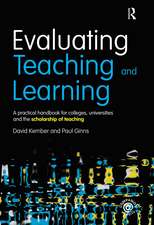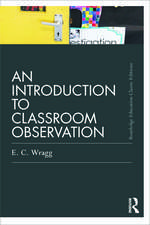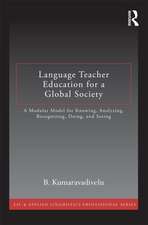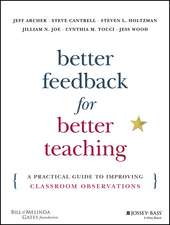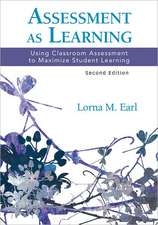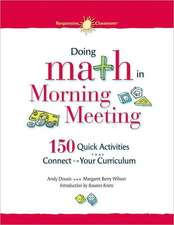Advancing the Three-Minute Walk-Through: Mastering Reflective Practice
Editat de Carolyn J. Downey, Betty E. Steffy-English, William K. Poston, Fenwick W. Englishen Limba Engleză Paperback – 30 noi 2009
In 2004, The Three-Minute Classroom Walk-Through introduced educators to the Downey Walk-Through, a practical approach to coaching and supervision that is now widely accepted and used. Offering an expanded examination of the Downey Walk-Through, this sequel to the bestseller focuses on the second part of the walk-through—the reflective follow-up conversation—and clarifies many of the common misconceptions and misapplications of the approach.
The authors illustrate how leaders can use observations from the walk-through to engage in professional conversations and encourage teachers to reflect on and improve their practice. Offering extended examples, activities, and guidelines for changing schools one teacher at a time, this resource shows school leaders how to:
- Provide effective follow-up discourse without criticizing or demoralizing teachers
- Build collegial and respectful relationships with faculty members
- Help teachers see their power to become continuously improving professionals
- Foster a collaborative process between headteachers, teachers, and other instructional leaders.
Preț: 308.76 lei
Nou
Puncte Express: 463
Preț estimativ în valută:
59.08€ • 61.68$ • 48.90£
59.08€ • 61.68$ • 48.90£
Carte tipărită la comandă
Livrare economică 04-18 aprilie
Preluare comenzi: 021 569.72.76
Specificații
ISBN-13: 9781412964579
ISBN-10: 1412964571
Pagini: 240
Dimensiuni: 178 x 254 x 17 mm
Greutate: 0.43 kg
Ediția:1
Editura: SAGE Publications
Colecția Corwin
Locul publicării:Thousand Oaks, United States
ISBN-10: 1412964571
Pagini: 240
Dimensiuni: 178 x 254 x 17 mm
Greutate: 0.43 kg
Ediția:1
Editura: SAGE Publications
Colecția Corwin
Locul publicării:Thousand Oaks, United States
Recenzii
"For the past decade, Carolyn Downey has paved the way for quality instructional leadership by framing the strategy of walk-throughs and follow-up conversations. Now Downey has taken the discussion one step further, taking a closer look at those reflective questions and conversations. In my school district of 70,000 students, walk-throughs and reflective questions are making a difference. School administrators are visible not only from a student behavior perspective, but also from a program/curriculum perspective. Reflective questions between the administrator and teacher set the stage for professional conversations. This is an important strategy for building professional learning communities in schools—and the students are the winners!"
"The implementation of Carolyn Downey’s walk-through observation techniques have been paramount to the success of administrators and students in the Shawnee Mission School District. The concept of administrators spending a portion of their day in classrooms and observing specific curriculum decisions along with instructional techniques and student behavior followed by reflective conversations has resulted in consistent, positive student achievement at all levels in the school district. Both teachers and administrators see the value of a cooperative effort to increase student achievement. I highly endorse Downey’s walk-through process. It’s a proven process that contributes to the positive relationship between teachers and administrators."
"This book provides the most informed and transformative blueprint known for building the capacity of teacher coaches and supervisors to enter into a relationship with teachers that is characterized by reflection, conversation, and collaboration. If you are ready to confront power and control issues on your campuses and embark on a journey of professionalizing the administrator/teacher connection for greater student success, then you have in this work a guide for enhanced respect, collegiality, and productivity all aimed at helping each of our students learn more and learn better. Districts across Texas are using the Downey walk-through approach to break through the barrier of the isolated classroom and provide a platform for improved dialogue about teaching and learning."
"This book builds upon the authors' earlier work , delving deeper into the follow-up of the walk through, reflective practice and collaboration. It is especially helpful for administrators who want to move their own professional development and that of their faculty from observation and evaluation to analysis and reflective inquiry."
"The implementation of Carolyn Downey’s walk-through observation techniques have been paramount to the success of administrators and students in the Shawnee Mission School District. The concept of administrators spending a portion of their day in classrooms and observing specific curriculum decisions along with instructional techniques and student behavior followed by reflective conversations has resulted in consistent, positive student achievement at all levels in the school district. Both teachers and administrators see the value of a cooperative effort to increase student achievement. I highly endorse Downey’s walk-through process. It’s a proven process that contributes to the positive relationship between teachers and administrators."
"This book provides the most informed and transformative blueprint known for building the capacity of teacher coaches and supervisors to enter into a relationship with teachers that is characterized by reflection, conversation, and collaboration. If you are ready to confront power and control issues on your campuses and embark on a journey of professionalizing the administrator/teacher connection for greater student success, then you have in this work a guide for enhanced respect, collegiality, and productivity all aimed at helping each of our students learn more and learn better. Districts across Texas are using the Downey walk-through approach to break through the barrier of the isolated classroom and provide a platform for improved dialogue about teaching and learning."
"This book builds upon the authors' earlier work , delving deeper into the follow-up of the walk through, reflective practice and collaboration. It is especially helpful for administrators who want to move their own professional development and that of their faculty from observation and evaluation to analysis and reflective inquiry."
Cuprins
About the Authors
Dedication
Preface
Considering the Ghosts in the Closet: Hegemony and Conflict Regarding Supervision and Evaluation in Schools
Examining the Classroom Walk-Through With Reflective Inquiry as a Discursive Practice
Understanding the Three Stages of Transformation With the Downey Approach
Examining the Text Analysis of the Three Transformational Stages
1. Building on the Philosophical Framework of the Three-Minute Walk-Through for Reflective Inquiry
Determining Your Values and Beliefs Regarding Human Behavior and Motivation and How These Influence Your Supervision Approach
Knowing How Your Beliefs Regarding the Human Nature of People Impacts Your Motivational Strategies
Using Various Types of Interactions Congruent With a Theory Y Philosophical Approach
Building Staff Capacity as a Way of Improving One's Practice
Posing Questions for Reflective Inquiry as the Way to Motivate Growth Rather Than Using Feedback
Being Reflective on Chapter Content
2. Considering the Various Approaches to Classroom Observations
Distinguishing Between Informal Walk-Throughs, Short Classroom Observations in Which Formal Data is Collected, and Principal-Supervisor Group Learning Walks
Identifying the Components Within the Classroom Observations to Determine Which Type of Observation to Use - Purpose, Primary Learner, Who Conducts the Observation, Observation Lens, Data Collected - if Such
Comparing the Various Approaches Using the Components
Clarifying the Meaning of "Walk-Through"
Being Reflective on Chapter Content
3. Clarifying the Misapplications in Using the Downey Walk-Through Five-Step Classroom Observation Structure
Clarifying the Five-Step Observation Structure Approach
Gathering Information on the Taught Objective: Content, Context, and Cognitive Type - Part I of Step Two
Analyzing the Curriculum Content - The First "C" of Step Two
Analyzing the Context of the Objective - The Second "C" of Step Two
Analyzing Cognition Type - The Third "C" of Step Two
Examining Congruence of the Teacher's Intended Objective With Actual Taught Objective - Part Two of Step Two
Calibrating the Taught Curriculum With the Expected Curriculum - Part Three of Step Two
Gathering Data on Instructional Practices - More on Step Three
Determingin When to and When Not to Interact With Others During the Observation
Being Reflective on Chapter Content
4. Creating a Culture of Reflection Through the Use of Walk-Throughs and Reflective Dialogue
Creating a Culture of Reflective Inquiry
Providing Opportunities for Reflective Dialogue
Using the Positive Presuppositional Phrases in the Downey Reflective Question
Expanding Teachers Outside Their Comfort Zone
Conducting a Reflective Dialogue to Lead to Collaborative Learning
Using the Reflective Conversation to Provide for Creativity and Challenging of the Status Quo
Being Reflective on Chapter Content
5. Moving People Toward Reflection
Providing a Foundation for Meaningful Reflective Practice
Promoting Reflective Thought and Transformative Learning
Moving Toward Interactive Conversations
Incorporating the Life Cycle Model
Using Direct Conversations: What the Principal Might Say
Using Indirect, Interdependent Invitation to Reflection
Using Collaborative-Interdependent Conversations
Being Reflective on Chapter Content
6. Adapting the Walk-Through and Reflective Conversation for Other Positions
Engaging in Reflective Inquiry With School Counselors
Engaging in Reflective Inquiry With Speech Language Pathologists
Engaging in Reflective Inquiry With School Nurses
Engaging in Reflective Inquiry With School Finance Officers
Engaging in Reflective Inquiry With Media Coordinators
Engaging in Reflective Inquiry With Chief Nutrition Directors
Thinking About All Positions for Reflective Inquiry
Being Reflective on Chapter Content
7. Adapting the Walk-Through and Reflective Conversation Approach for Peer Coaching and Mentoring
Valuing the Downey Model for Peer Coaching and Modeling
Listening to a Sample Dialogue Between Peers Using the Downey Approach
Implementing the Peer Walk-Through With Reflective Inquiry Approach
Using a Peer Protocol for the Walk-Through and Reflective Inquiry
Being Reflective on Chapter Content
8. Authenticating the Three-Minute Walk-Through and Reflective Inquiry and Practice With Recent and Legitimate Research
Providing Basic Foundational Research on Walk-Through Practices
Considering the Limitations of Using External Feedback
Valuing Supervisor Visibility and Instructional Improvement
Understanding the Power of Reflective Practice and Professional Growth
Considering Reflective Practice and Experience
Being Reflective on Chapter Content
9. Using the Walk-Through and Reflective Dialogue to Create Professional Learning Communities
Using the Downey Model of Reflective Practice in Professional Learning Communities
Understanding the Leadership Responsibilities and Requirements in the Professional Learning Community
Building Capacity for Professional Learning Communities to Develop Reflective Questions and Carry Out Reflective Conversations
Considering the Implications for School Leaders
Constructing a Learning Organization: A Summary
Being Reflective on Chapter Content
10. Institutionalizing the Three-Minute Walk-Through and Reflective Inquiry
Understanding the Prerequisites in Terms of Curriculum
Considering the Prerequisites in Terms of Culture
Considerations for Successful Full-Scale Implementation of the Model
Being Reflective on Chapter Content
References
Index
Dedication
Preface
Considering the Ghosts in the Closet: Hegemony and Conflict Regarding Supervision and Evaluation in Schools
Examining the Classroom Walk-Through With Reflective Inquiry as a Discursive Practice
Understanding the Three Stages of Transformation With the Downey Approach
Examining the Text Analysis of the Three Transformational Stages
1. Building on the Philosophical Framework of the Three-Minute Walk-Through for Reflective Inquiry
Determining Your Values and Beliefs Regarding Human Behavior and Motivation and How These Influence Your Supervision Approach
Knowing How Your Beliefs Regarding the Human Nature of People Impacts Your Motivational Strategies
Using Various Types of Interactions Congruent With a Theory Y Philosophical Approach
Building Staff Capacity as a Way of Improving One's Practice
Posing Questions for Reflective Inquiry as the Way to Motivate Growth Rather Than Using Feedback
Being Reflective on Chapter Content
2. Considering the Various Approaches to Classroom Observations
Distinguishing Between Informal Walk-Throughs, Short Classroom Observations in Which Formal Data is Collected, and Principal-Supervisor Group Learning Walks
Identifying the Components Within the Classroom Observations to Determine Which Type of Observation to Use - Purpose, Primary Learner, Who Conducts the Observation, Observation Lens, Data Collected - if Such
Comparing the Various Approaches Using the Components
Clarifying the Meaning of "Walk-Through"
Being Reflective on Chapter Content
3. Clarifying the Misapplications in Using the Downey Walk-Through Five-Step Classroom Observation Structure
Clarifying the Five-Step Observation Structure Approach
Gathering Information on the Taught Objective: Content, Context, and Cognitive Type - Part I of Step Two
Analyzing the Curriculum Content - The First "C" of Step Two
Analyzing the Context of the Objective - The Second "C" of Step Two
Analyzing Cognition Type - The Third "C" of Step Two
Examining Congruence of the Teacher's Intended Objective With Actual Taught Objective - Part Two of Step Two
Calibrating the Taught Curriculum With the Expected Curriculum - Part Three of Step Two
Gathering Data on Instructional Practices - More on Step Three
Determingin When to and When Not to Interact With Others During the Observation
Being Reflective on Chapter Content
4. Creating a Culture of Reflection Through the Use of Walk-Throughs and Reflective Dialogue
Creating a Culture of Reflective Inquiry
Providing Opportunities for Reflective Dialogue
Using the Positive Presuppositional Phrases in the Downey Reflective Question
Expanding Teachers Outside Their Comfort Zone
Conducting a Reflective Dialogue to Lead to Collaborative Learning
Using the Reflective Conversation to Provide for Creativity and Challenging of the Status Quo
Being Reflective on Chapter Content
5. Moving People Toward Reflection
Providing a Foundation for Meaningful Reflective Practice
Promoting Reflective Thought and Transformative Learning
Moving Toward Interactive Conversations
Incorporating the Life Cycle Model
Using Direct Conversations: What the Principal Might Say
Using Indirect, Interdependent Invitation to Reflection
Using Collaborative-Interdependent Conversations
Being Reflective on Chapter Content
6. Adapting the Walk-Through and Reflective Conversation for Other Positions
Engaging in Reflective Inquiry With School Counselors
Engaging in Reflective Inquiry With Speech Language Pathologists
Engaging in Reflective Inquiry With School Nurses
Engaging in Reflective Inquiry With School Finance Officers
Engaging in Reflective Inquiry With Media Coordinators
Engaging in Reflective Inquiry With Chief Nutrition Directors
Thinking About All Positions for Reflective Inquiry
Being Reflective on Chapter Content
7. Adapting the Walk-Through and Reflective Conversation Approach for Peer Coaching and Mentoring
Valuing the Downey Model for Peer Coaching and Modeling
Listening to a Sample Dialogue Between Peers Using the Downey Approach
Implementing the Peer Walk-Through With Reflective Inquiry Approach
Using a Peer Protocol for the Walk-Through and Reflective Inquiry
Being Reflective on Chapter Content
8. Authenticating the Three-Minute Walk-Through and Reflective Inquiry and Practice With Recent and Legitimate Research
Providing Basic Foundational Research on Walk-Through Practices
Considering the Limitations of Using External Feedback
Valuing Supervisor Visibility and Instructional Improvement
Understanding the Power of Reflective Practice and Professional Growth
Considering Reflective Practice and Experience
Being Reflective on Chapter Content
9. Using the Walk-Through and Reflective Dialogue to Create Professional Learning Communities
Using the Downey Model of Reflective Practice in Professional Learning Communities
Understanding the Leadership Responsibilities and Requirements in the Professional Learning Community
Building Capacity for Professional Learning Communities to Develop Reflective Questions and Carry Out Reflective Conversations
Considering the Implications for School Leaders
Constructing a Learning Organization: A Summary
Being Reflective on Chapter Content
10. Institutionalizing the Three-Minute Walk-Through and Reflective Inquiry
Understanding the Prerequisites in Terms of Curriculum
Considering the Prerequisites in Terms of Culture
Considerations for Successful Full-Scale Implementation of the Model
Being Reflective on Chapter Content
References
Index
Descriere
This sequel to the bestseller provides extended perspectives, activities, and guidelines for changing schools.

